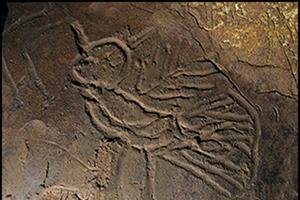1 of 3 | A drawing located inside The 19th Unnamed Cave in Alabama, where researchers confirmed on Wednesday, North America's largest cave glyphs have now been discovered, using a new 3-D modeling technique. Photo courtesy Cambridge University Press
May 5 (UPI) -- The largest known examples of North American cave drawings have been discovered in Alabama using a new identification technique, according to research published by Cambridge University Press on Wednesday.
The 19th Unnamed Cave in Alabama contains hundreds of pre-contact Native American mud glyph drawings that were uncovered using 3D modeling, first initiated in 2017.
The technique enabled "digital manipulation of the chamber space and revealing images that could not be perceived prior to modeling," according to researchers at the University of Tennessee, Knoxville.
Officially known as the 19th Unnamed Cave, the subterranean space in northern Alabama extends for miles beneath the surface. Hundreds of carved figures are located on the ceilings.
Archaeologists estimate the carvings were made about 1,000 years ago by people living during the Woodland phase of the Native American culture in the region.
The glyphs could depict spirits of the underworld and have been dated to the first millennium AD.
Photogrammetry is a software-based 3D modeling technique that begins by taking many photographs of a target. Each photograph overlaps its neighbor by 60% to 80%. Software then compares the images and overlaps, and then calculates the camera positions used to produce the images.
In the 19th Unnamed Cave, scientists created three interlinked models. Two were of the engraved ceiling and a third model of the undecorated cave passages.
"We knew the cave contains precontact Native American mud glyphs, and we were carrying out a 3D photogrammetry documentation project to aid with management and conservation," said Jan F. Simek, a University of Tennessee, Knoxville professor and the study's lead author.
"The very large cave art images cannot be seen in person in the cave because of the constrained spaces on the site."















